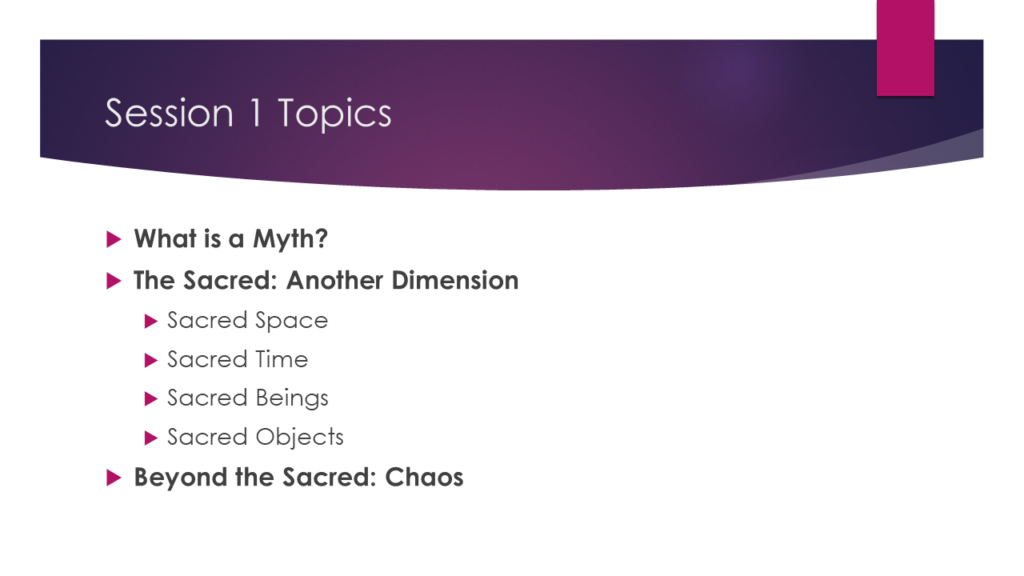
Last session, we talked about the conceptual framework in which all myth exists. Every myth is a story that serves a purpose. It can be used to celebrate events or heroes, to model ideal behavior, or to explain the origin of things. “Myth, in its most acceptable definition, is simply a society’s attempt to dramatize its faith in its own identity and institutions…”[1]
When we adopt a mythical perspective, we leave the world of the positive sciences and enter the world of the sacred. Without an appreciation for the sacred, myth loses its power to convey meaning and truth, and appears ridiculous to say the least. Although myth may have its roots in physical space and time, and may refer to historical characters and physical objects, it does not belong there. Myth invites us into sacred space where there is neither place nor dimensions and moves us into sacred time, where there is no moment or duration, only an ever-present “now.” Myth introduces us to sacred beings who live now outside of physical space and time, and sacred objects which serve as doors to the sacred.
Finally, we spoke about chaos—the disorder that surrounds and threatens us. Chaos is the realm of pure possibility. It’s the locus of everything that could have been, but was not, might be, but is not, and could be but will not be. Chaos is Shiva, the Destroyer, returning everything to the stuff from which it was made.
Today, we’re going to look at what came before Genesis. The authors of our Judaeo-Christian Scriptures did not live in a cultural or historical vacuum They did not invent creation storytelling. By the time the Hebrew Scriptures were composed, there was already at least a thousand years of written material available to them. It’s important for us to have even a sketchy understanding of the myths the early Hebrew peoples lived with.

This is a map of the ancient Near East. As we’ll see in a moment, nearly all the peoples listed here (outside of Egypt) are identified as Semitic. The Hittites, the Assyrians, the Babylonians, all spoke Semitic languages, had similar cultures, and held similar beliefs. The Hittites were particularly warlike, and invaded not only Assyria and Babylonia, but also conquered Egypt and put their own kings on Egypt’s throne. The Pharaoh of the story of Joseph, later on in Genesis, was of Hittite descent.
Now, let’s take a look at the most ancient of the civilizations in the Tigris-Euphrates valley.

The yellow circle shows you the region called Sumer. The Sumerians were not originally a Semitic people, and their language is not related to any other known languages. It was the Sumerians who first used a pointed stick in wet clay to keep accounts, so that, by around 2900 BC, they had developed the first cuneiform writing system and created the first written literature ever. The red circle on the map indicates the major city of Ur, which is where Abraham originated a thousand years later (around 1900 BC). I want you to take note of several of the other Sumerian cities located around Ur. To the south is Eridu, where one of the earliest creation stories was composed. North of Ur is Uruk, where the greatest king of early Mesopotamia lived. His name was Gilgamesh. North of Uruk is a town called Faro on our map. In Sumerian times, the name of the city was Shuruppak. We’ll be seeing why those cities are important for us in just a moment.

Here are some of the important texts composed by the Sumerians. Notice how old the Instructions of Shuruppak are. They date from only a couple of centuries after the invention of writing. They are proverbs and commandments that were written to Ziusudra, the son of King Ubara-tutu of Sumer. Ubara-tutu is listed in the Kings List as the last king before the flood. Ziusudra, we shall see, was the man who was instructed by a god to build a boat to survive the flood. The Instructions of Shuruppak, and all the source documents that I’ll be mentioning (except the Kings List) are available online in the transcript of this session [click here]. As I mentioned, the Kings List gives the kings of Sumer who reigned both before and after the deluge.
In the Epic of Gilgamesh, the hero is told about the great flood and how people were saved from it. Gilgamesh, king of Uruk, was an historical figure who lived about the same time as when the Instructions of Shuruppak were written. He is, of course, mentioned prominently in the Kings List.
Finally, the Eridu Genesis, composed in the city of Eridu—remember them?—tells of the world being created out of a primordial sea, the creation of the gods and humans, and finally the great deluge and the escape of the hero, Ziusudra whom we met in the Instructions of Shuruppak. There’s also a link to the Eridu Genesis text in our session transcript [click here].

As time progressed, the city of Akkad grew in prominence. The Akkadians were a Semitic language-speaking people who lived in the fertile crescent to the north of the Sumerians. Their approximate territory is circled in yellow. The two cultures mingled thoroughly, so that the Sumerian and Akkadian languages were spoken and written interchangeably. We do not yet know the location of the city of Akkad, but it’s speculated that it was close to the city of Nippur, which is circled in red on our map.

The Akkadians were the predecessors of the Babylonians, whose territory included all of Sumeria and Akkadia. See the yellow circle. The city of Babylon is circled in red. The Babylonian literature was a combination of both sources, although eventually, under Babylon, the Sumerian spoken language died out. If you look carefully at the map, you’ll see an Akkadian city very close to Babylon—within the same red circle. It’s the city of Kish. Please take note of it, you’ll see it again.

Here we see the combined literature of the Sumerians and Akkadians. The Akkadians added traditional stories about Gilgamesh to the Sumerian Epic and translated it into their own language. It’s quite long but, if you’re interested in it, I’ve provided a link to the text in our session transcript [click here].
The Enuma Elish is a creation myth starring the god-hero Marduk, the principal deity of both the Akkadians and then later the Babylonians. We’ll be looking at the Enuma Elish in much greater detail in a moment. The final text I’m showing here is the Epic of Atra-Hasis. In this story, it’s the Assyrian king, Atra-Hasis, who’s told by a god to build a boat and who escapes the great deluge. This story is also available in the transcript [click here]. That leads us to ask a very familiar question: “Was there a great deluge?”

Was there ever a “Great Flood”? We’ve already seen it mentioned throughout the literature of the ancient Near East in the Epic of Gilgamesh, the Kings List, the Eridu Genesis, and the Epic of Atra-Hasis. What about it? Was there really a flood? Archaeologists have found evidence of major floods in the area. There is parallel evidence from excavations at Shuruppak in Sumeria and Kish in Akkadia—remember them?—both from around 2900 BC. That date squares well with our earliest written texts and the dates of Gilgamesh the king. But then, there was a much more severe flood at Ur around 3500 BC. That was way before writing was invented. So which flood was it?

I’ve indicated on our map the approximate location of the floods—around Shuruppak (called Faro) up to Kish near Babylon, and down as far as Ur. To make sense of this, we have to turn back to our understanding of sacred space and time.

Was there ever a flood? Unequivocally, yes. Historically, which one was Noah’s flood? devastating floods obviously occurred from time to time in the Tigris-Euphrates valley. In each one, many people were killed, much was destroyed, and some people were saved, some would say miraculously. In myth, the salvation event is shifted into sacred space and time. It happens in some generic place—often “nearby”—and at some generic time—often “long ago.” In this sacred time, we find a sacred being—a hero—who has a divine revelation and is saved. The identity of the person is unimportant: Ziusudra, Atra-Hasis, or Noah. The hero is assigned the name of a prominent person from local folklore, or of a particular hero-god. Can you see how the realm of the sacred transforms human events into sacred myths?
Why are we talking about Noah and the flood from the fifth chapter of Genesis, when we haven’t even started chapter one? There are several reasons. The first is, of course, to illustrate how mythical events take place in sacred time and space to sacred beings to teach important lessons. Another reason has to do with a special object—in this case, water.
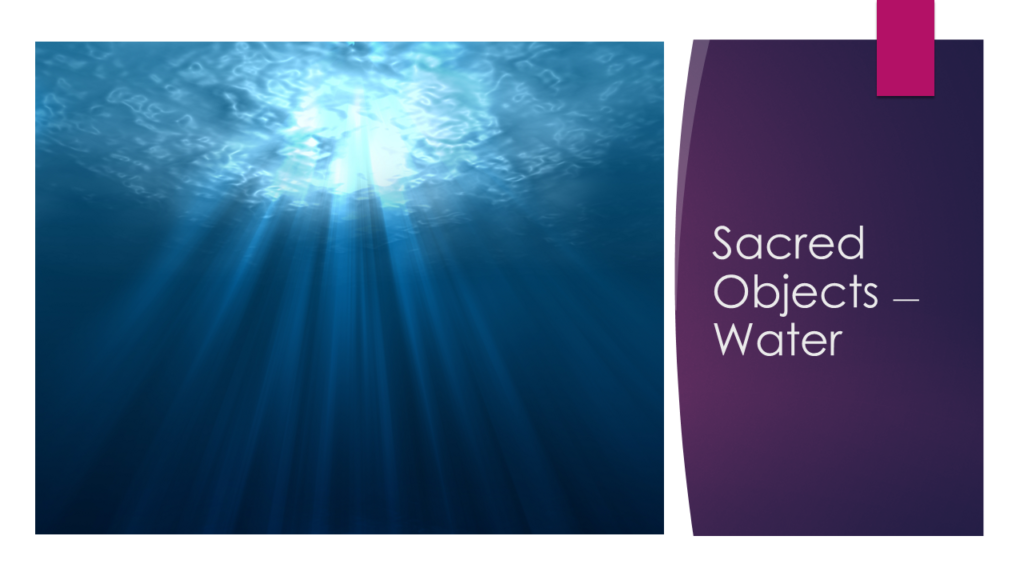
Water is a very special type of object. It’s necessary for all life. Where there is no water, there is no life. When water comes, life emerges and thrives. As we’ve just seen, when too much water comes, there’s destruction and death. The flood brings both destruction and rebirth: the eternal cycle of life, moving from birth to death to rebirth. Yet, the new birth is not the same as the old one. It’s new. It’s different. It’s unprecedented. Water, and what comes from it manifests itself in a nearly infinite variety of forms. Water is pure possibility. It can become anything; therefore, it’s nothing. It’s latent because it isn’t anything yet. And it’s virtual—it’s potentially anything. We can define water as the sum of virtualities.
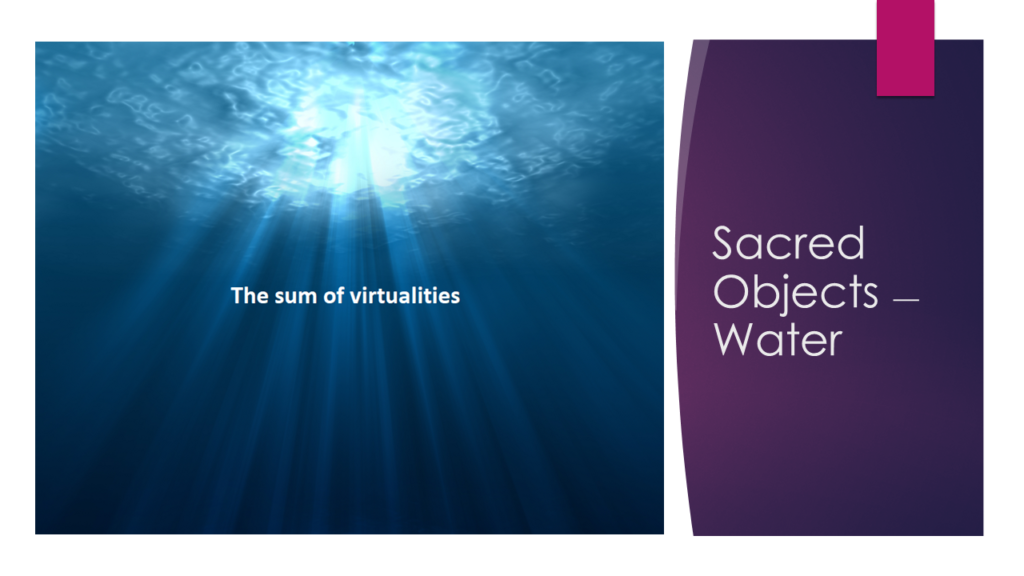
Water has neither shape nor form. And what’s equally important to understand, it’s everywhere. It surrounds dry land on every side. It appears in lakes, streams, and rivers. It lies underground even in the desert in vast aquifers, and it falls from the sky. Sacred space is encompassed by and inundated with water. Does any of this sound familiar? Remember chaos?
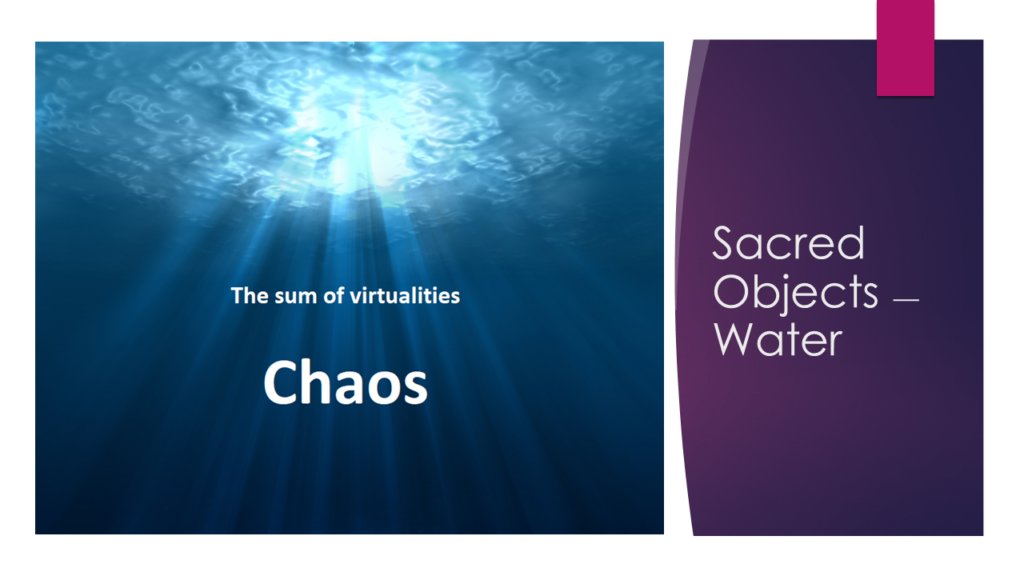
What did we say about it in our first session? Every ancient creation story from the Near East begins with the waters of chaos. It was there in the Sumerians, Akkadians, and Babylonians. It was adopted by the Hittites and brought into Egypt. And it found its way into the mythology of the Hebrews. Chaos surrounds sacred space and brackets sacred time. It gives birth to sacred beings and makes sacred objects. It also threatens them with destruction. I’d like to show you briefly how the ancients imagined the waters of chaos by taking a quick look at the creation myth we mentioned earlier: the Akkadian epic known as the Enuma Elish. You can download your own copy of the text from this session’s transcript [click here].
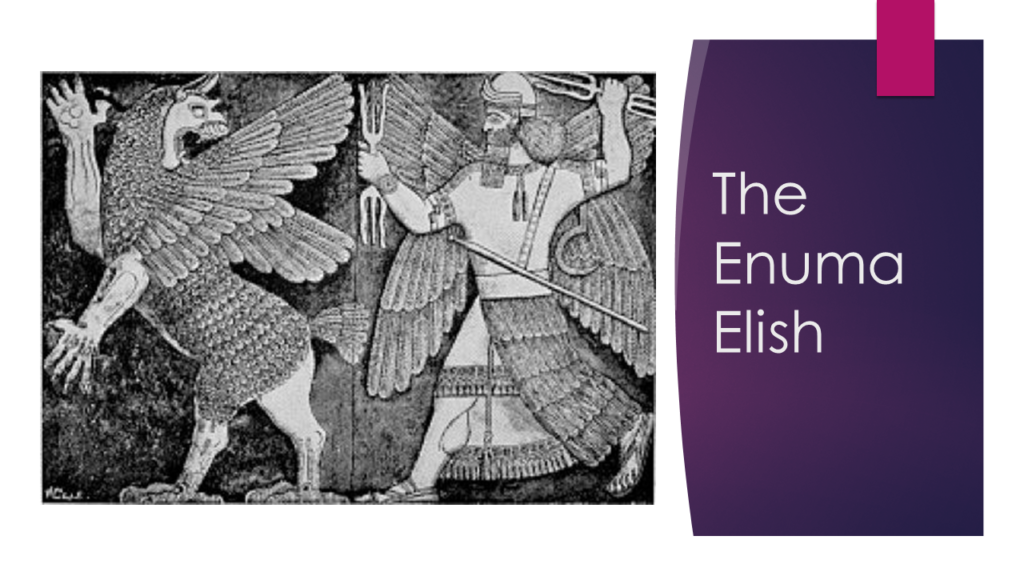
The title of the myth comes from its opening words, “When on high.” In this image, you’ll see a Babylonian representation of the two main characters from this epic. The water monster Tiamat is on the left, confronting the hero-god Marduk on the right. He carries in his hands his tools of storm and lightning. Here’s the opening stanza of the epic:
When in the height heaven was not named,
And the earth beneath did not yet bear a name,
And the primeval Apsu, who begat them,
And chaos, Tiamut, the mother of them both
Their waters were mingled together,
And no field was formed, no marsh was to be seen;
When of the gods none had been called into being,
And none bore a name, and no destinies were ordained;
Then were created the gods in the midst of heaven,
Lahmu and Lahamu were called into being…
Ages increased,…
As mentioned in the text, Tiamat was the personification of the primordial water of the seas, while Apsu was the personification of the primordial fresh waters of the underground. Note that heaven and earth had no name, so they did not exist. Also, Apsu and Tiamat are not gods. They’re the primordial beings from whom the gods were created. Where and when was this? In sacred space and time, of course.
As the story continues the gods—children of Apsu and Tiamat—rebelled against them and made Tiamat angry. She warred against everything and everyone that had been created. Anu, the personification of the sky and first of all the gods, had a son, Ea, god of created water. Ea then begat Marduk, the hero-god. As a warrior, Marduk volunteers to go into battle against Tiamat on behalf of the gods.
In the battle that we see in the picture, Tiamat opens her mouth to devour Marduk, but he captures her in his net and throws the storm winds at her, entering her open mouth and filling her to bursting. He then slays her and cuts her in half. One half, he places in the sky, out of the other half, he creates the earth, and all living things.
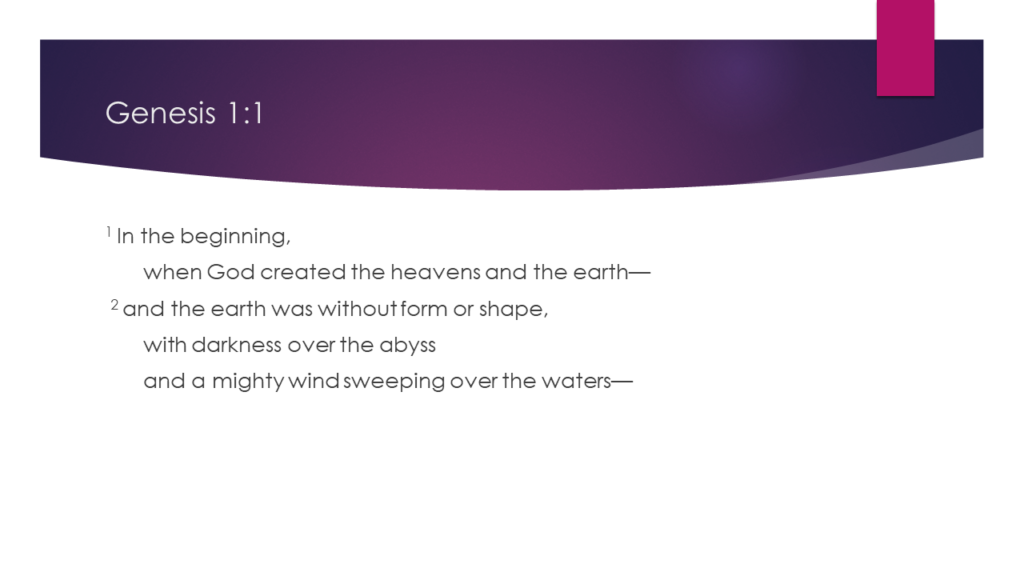
Now, finally, we can start looking at the Book of Genesis. Here are the opening lines. It begins, “In the beginning…” This tells us something important: we are entering sacred space and time. It is when? A long time ago. It is the time when God—Elohim—created. But Genesis is not, strictly speaking, a creation story. It’s a formation story. It doesn’t deal with creation of the universe out of nothing. It deals, rather, with the origins of everything. It’s the family history of the human race. It’s humanity’s Roots like Alex Haley’s book. It’s in perfect alignment with the Mesopotamian myths.
It says “…God created the heavens and the earth.” This is a figure of speech that’s rare in our literature, but you’ll find it throughout the Judaeo-Christian Scriptures. It’s called a merism and it’s formed by taking two words from the extremes of something to refer to everything in between. Don’t we say, “the winners and the losers” to refer to everyone who plays the game? So, here, “the heavens and the earth” means literally everything. And even though Genesis talks about the heavens and the earth, they’re not personified. They’re not Ansu and Tiamat. Although we may speak of Genesis as a myth, the author has taken the ancient creation stories and demythologized them. The primordial beings and the gods have been erased.
“The earth was without form and shape.” The earth, הארץ (ha-aretz), the land was ובהו תהו (tohu wa-bohu). Tohu: formless, virtual, chaotic. And bohu: empty, void, vacant. A formless emptiness. Can you think of a better description of chaos? It’s brilliant.
“…with darkness over the abyss.” The abyss—תהום (teḥom). It’s impossible when we hear the word abyss—teḥom—not to think of its cognate, Tiamat. There is so much nothing, so much chaos, that there’s not even light.
“…and a mighty wind sweeping over the waters.” Wind over water. Think of Marduk using his storm wind to destroy the water monster Tiamat. However, in Hebrew the wind is the רוח אלהים (ruaḥ Elohim). Ruaḥ means wind. It also means breath of life. It also means spirit. So there are multiple possible meanings of this passage—all of them true: for example, a godly (that is, mighty) wind, the breath of God, the Spirit of God. It’s deliberately ambiguous. It means any of those things and all of them.
One final note: “the ruaḥ Elohim sweeping over the waters.” What waters? Now you know.
Click Here for Session Video
Sources:
Prichard, James B. (Ed.), The Ancient Near East, An Anthology of Texts and Pictures, Princeton, NJ: Princeton University Press, 1958.
Vawter, Bruce, On Genesis a New Reading, New York: Doubleday & Co., Inc., 1977.
[1] Bruce Vawter, On Genesis a New Reading, New York: Doubleday & Co., Inc., 1977, p. 27.
